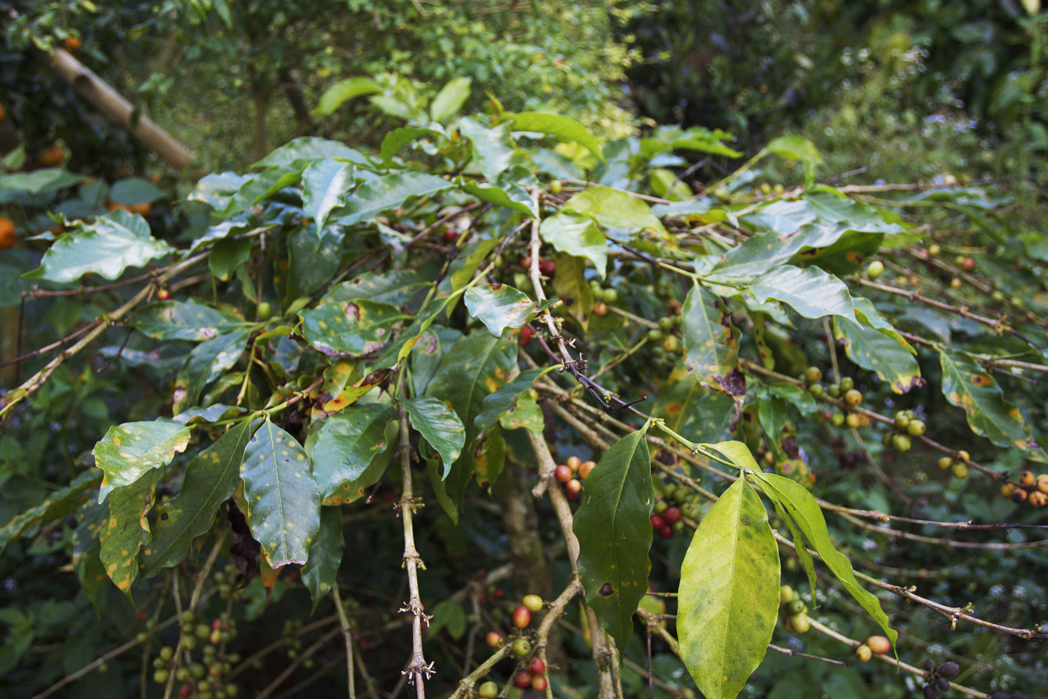
Coffee leaf rust is sometimes characterized by brown spots on plant leaves, leading to defoliation and lack of productivity. The image “coffee leaf rust defoliation” by Michael C. Wright is licensed under CC BY-SA 4.0
Most people reading the news over the past two-plus years now know more about disease variants and transmission than they ever may have wished.
Yet new discoveries came to light just this spring in research conducted on the genetic nature of the disease that has beleaguered coffee producers for more than a century: coffee leaf rust, or CLR.
Researchers from the University of Tsukuba in Japan examined the occurrence of CLR disease in major coffee-growing regions of Vietnam, including arabica and robusta coffee varieties in field surveys.
One of the report’s most concerning findings is that arabica coffee varieties that were previously considered more resistant to Hemileia vastatrix, the fungus that causes leaf rust disease, were found in some cases to have lost resistance to new varieties of the disease.
“The results of field investigations show that the leaf rust disease is present in all coffee growing regions in Vietnam, from South to North, and from low altitudes to high mountainous areas,” the study authors wrote. “These observations suggest that all coffee species and cultivars planted in Vietnam now are susceptible to rust disease.”
The study further found that Catimor arabica cultivar, which is found in Northwest Vietnam growing regions and has historically been considered resistant to rust, is in fact widely susceptible to the disease.
“The number and size of the rust lesions was large on the coffee tree leaves in the Northwest plantations, where Catimor varieties are predominately planted,” the authors wrote.
The findings bring to mind the case of the Lempira coffee variety in Honduras, which was widely adopted for its rust-resistant properties yet later became susceptible to variations of the disease. Researchers and coffee experts in Colombia have issued similar warnings about increasing susceptibility as aggressive CLR variants emerge. In 2018, renowned coffee plant scientist and former World Coffee Reasearch scientific director Christophe Montagnon warned that coffee varieties all over the world were rapidly losing their resistance to leaf rust.
The new study explores the genetic diversity of CLR itself, noting that strains found in parts of Vietnam closely resemble rust strains that have threatened crops throughout the Americas over the past decade.
“To control this disease, we need to understand rust population diversity,” study senior author Izumi Okane said. “We must also identify the genetic variations that underpin it, and anticipate potential future variations.”
The Japanese study also explored how rust fungi migrate to different geographic regions. In Vietnam, the spread of CLR from the northern growing regions to the southern regions revealed that “agents other than wind and monsoon were involved in moving spores from an infected region to other areas.”
Thus, the study calls for a three-pronged approach to mitigating the spread of coffee leaf rust globally, including “human-mediated activities” to help prohibit the spread, the continued cultivation of disease-resistant varieties, and much deeper understanding of the disease’s genetic diversity.
Said Okane, “Our study highlights the need to consider human-mediated activities, because they may quickly accelerate the genetic diversification of rust fungi populations.”
The full study, called “Incidence of Coffee Leaf Rust in Vietnam, Possible Original Sources and Subsequent Pathways of Migration” was published in Frontiers in Plant Science in April 2022.
Does your coffee business have news to share? Let DCN’s editors know here.
Nick Brown
Nick Brown is the editor of Daily Coffee News by Roast Magazine.






Comment